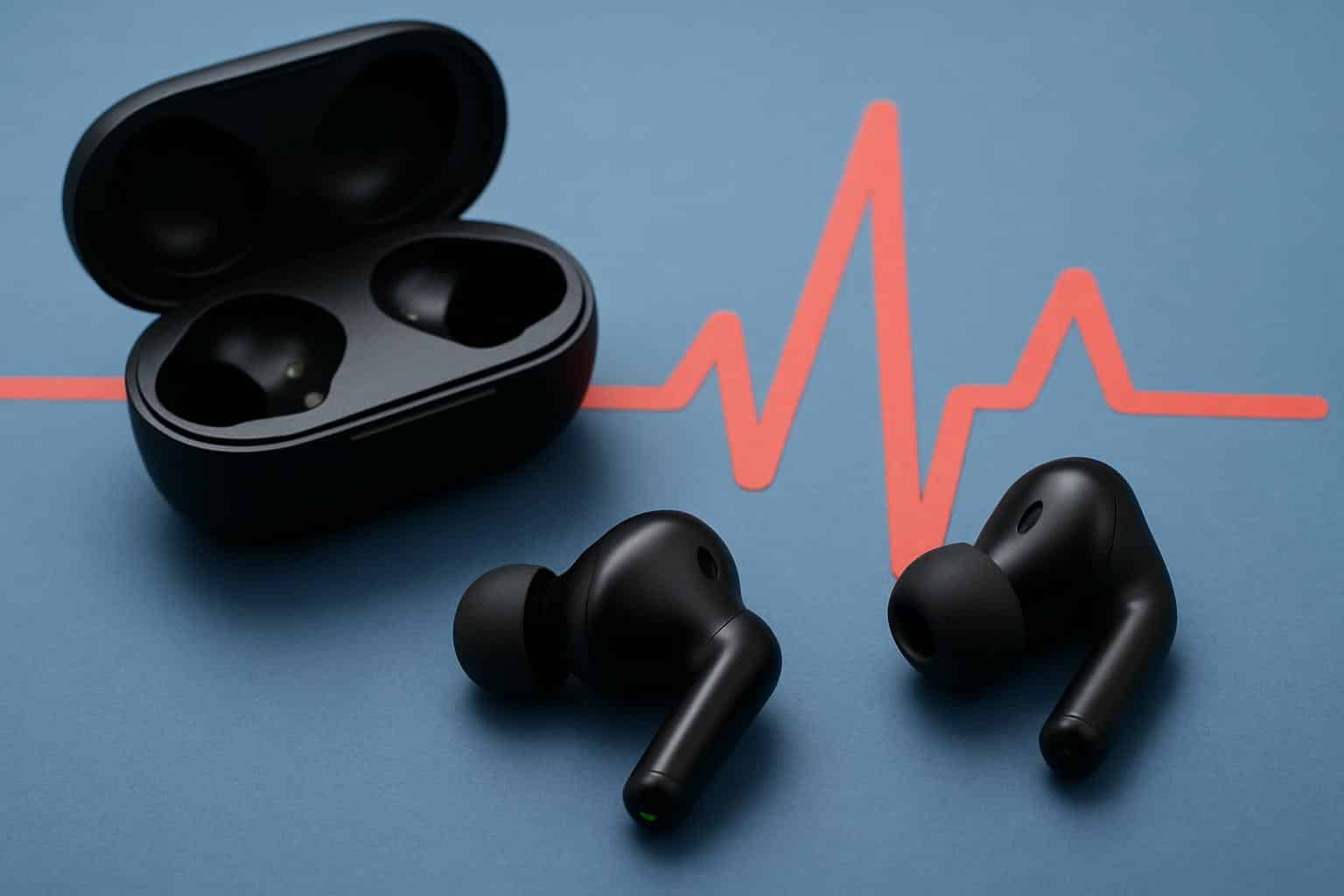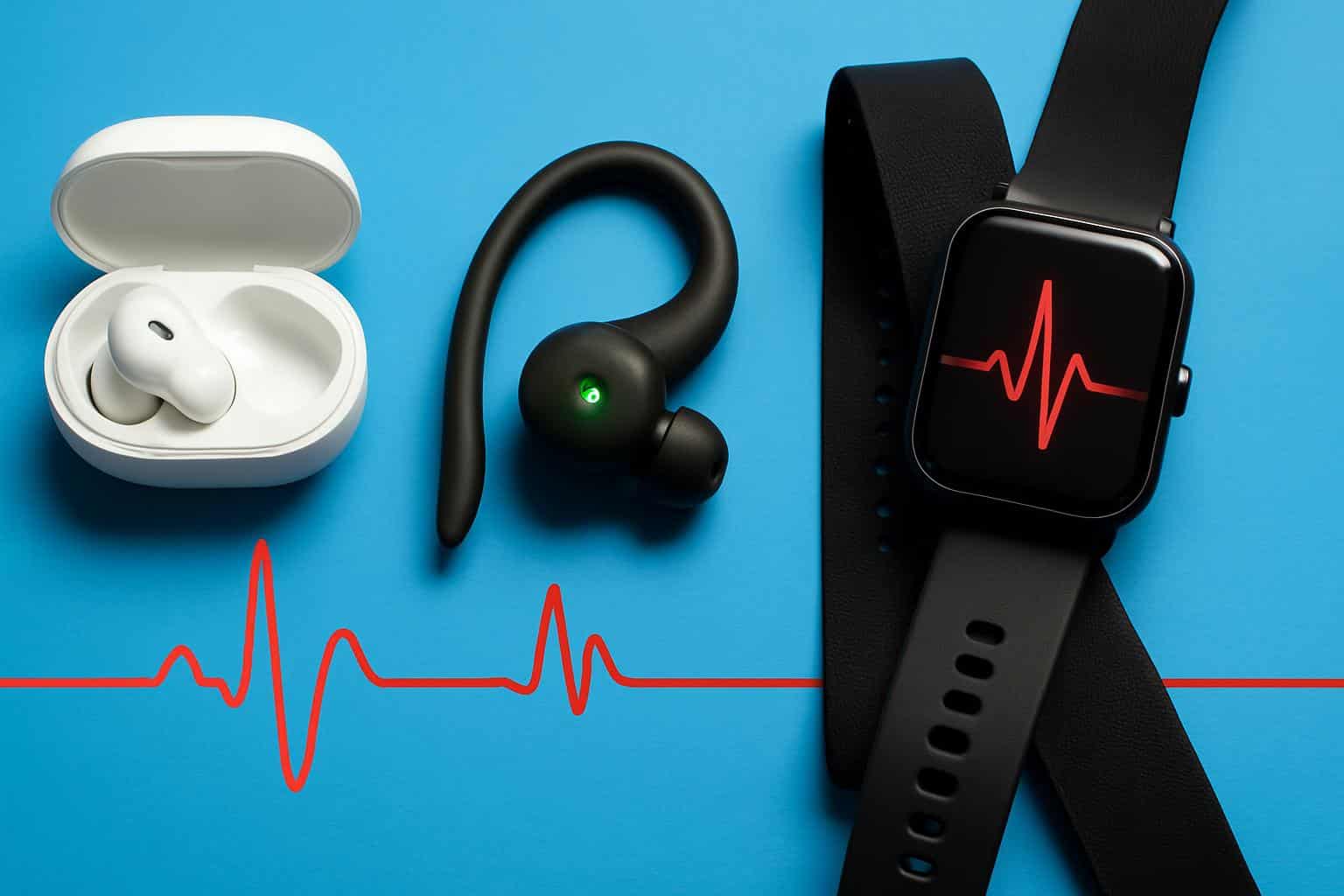In-ear heart rate sensors are finally appearing in mainstream earbuds, delivering workout metrics without needing a watch or chest strap.
Against a chest-strap reference, I sampled two current pairs that feature built-in photoplethysmography (PPG) — one utilizing an ear-hook design for stability and another with a dainty, stem-based fit. The short version: earbud heart rate tracking is a reality for day-to-day fitness and regular runs, but it’s not there yet as an alternative to the chest strap in high-intensity or clinical settings.

How in-ear sensors measure pulse using ear PPG
Earbuds take advantage of PPG, which shines light into tissue while measuring the reflected signal that varies with blood volume changes. About 30%–40% of people cannot comfortably wear an ear clip, which can be inconvenient for service personnel. There are many advantages to using the ear to measure: ear testing can be faster (1-second testing time) and more accurate than forehead testing; you don’t need to touch a baby’s forehead, so your baby won’t wake up when they’re sleeping. The ear has advantages over the wrist: good blood perfusion (larger blood vessels than the hand and finger), less hair, and a relatively constant temperature, etc. That’s the reason clinical-grade ear-clip oximeters were invented. The challenge is motion. Chewing, speaking, jaw clenching, and cable or shell micro-vibrations can produce noise interference on the optical signal. The quality of the seal is also a factor: any leak of light will increase noise.
In peer-reviewed studies in IEEE biomedical journals and the Journal of Sports Sciences, ear PPG has been reported to correlate well with ECG-based HR at rest as well as during steady-state exercise, with many showing mean absolute percentage errors (MAPE) below 3% at rest and 5–8% at moderate work. Error can also spike above 10% during rapid intensity changes or heavy-impact distractions due to motion artifacts and algorithm delay. None of these consumer earbuds is a medical device, and manufacturers are careful to say so.
What my real-world tests revealed about earbud HR accuracy
I did two sessions back-to-back with a Polar H10 chest strap as the reference. Workouts featured a 30-minute easy run, an indoor cycling interval set, brisk walks combined with phone calls to stimulate jaw movement, and HIIT sprints. I also checked in cool morning air, which tends to challenge optical sensors with vasoconstriction.
In consistent efforts, the two earbuds followed one another quite closely. Mean error was 2–4 beats per minute versus the chest strap, and trend lines were similar. The ear-hook variant generated fewer dropouts with an anchored fit, especially during outdoor runs. At intervals, the two pairs exhibited a delay of approximately 2–6 seconds on the upswing and an under-reading of peak heart rate by as much as 5–12 bpm. Swift recoveries were depicted far more reliably than swift spikes. Cold starts were error-prone until I warmed up.
Calls and jaw motions did indeed add noise: short peaks or plateaus that algorithms smoothed out after several seconds. On a positive note, long steady efforts did not show any meaningful drift, and the optical signal remained consistent with the chosen right-ear tip size. If the fit slipped, accuracy went south in a hurry — and ear geometry is a personal thing, so fit is king.
When Earbuds Work Well And When They Don’t
Where they excel: brisk walks, zone 2 runs, tempo rides, and gym circuits with low to moderate impact. The rolling average is smooth, and the numbers suffice to pace by and provide an idea of calorie burn. Where they slip: sprint repeats, plyometrics, jumping rope, and quick surges, especially if sweat causes the seal to lose its grip. Anticipate minor peak under-reporting and slight delays when there is a sudden intensity rise.

Environmental and physiological factors matter. PPG is compromised by poor fit or light leaks. In very dry or very cold conditions, perfusion may be much lower and the signal can become completely flat. It’s not so much the darker pigment itself that is usually to blame; it’s more likely motion and light contamination. Foam tips made a big difference to stability for me, and the ear-hook design was more accepting of hard efforts.
Battery, comfort, and platform caveats for earbud HR
There’s power consumed with continuous heart rate polling. Throughout my runs, battery life decreased by an additional 5–10% per hour with HR monitoring on compared with audio-only listening. That’s fine for most workouts, but something to keep in mind if you employ active noise cancellation as well. Comfort comes into it, too: an ear hook is great for sprinting but might feel cumbersome if you’re wearing them all day; compact buds are more discreet, but they rely purely on tip seal.
Platform support differs. On iOS, heart rate from all pairs smoothly integrated with the Health and Fitness apps and showed real-time zones. Only the ear-hook model I tested on Android exposed HR and basic metrics through its companion app, with limited advanced integrations. Device ratings also differ: one pair has IP57 dust and water protection, the other is rated for IPX4 splash resistance — something to consider if you train on dusty trails or in heavy rain.
Finally, remember scope. Earbuds provide an estimate of your heart rate and basics about a workout; they can’t diagnose irregular rhythms, measure clinically meaningful heart rate variability, or accurately determine VO2 max. Professional societies and sports science labs continue to consider chest straps the standard for high-intensity training.
Clear buying advice for choosing heart rate earbuds
Earbud heart rate tracking is ready if you do mostly steady cardio. You’ll receive reliable averages, useful trends, and convenience that cannot be matched by a chest strap. Get the most secure fit that you can stand; a tight ear hook or a good seal will make more difference than any marketing-fluff resistance rating.
If you train to specific zones, do HIIT, or care about catching every beat in sharp surges, keep a chest strap around and treat earbud HR as a second data stream. It’s grade‑A integration for iPhone and more limited cross‑platform support elsewhere (with some basics, like songs and heart‑rate features, not being supported on Android — check the specific earbuds/app packages to see what works in general). At best, think of in-ear heart rate as a smart convenience, not a medical instrument — admirably helpful but ultimately governed by the laws of physics and physical fit.

